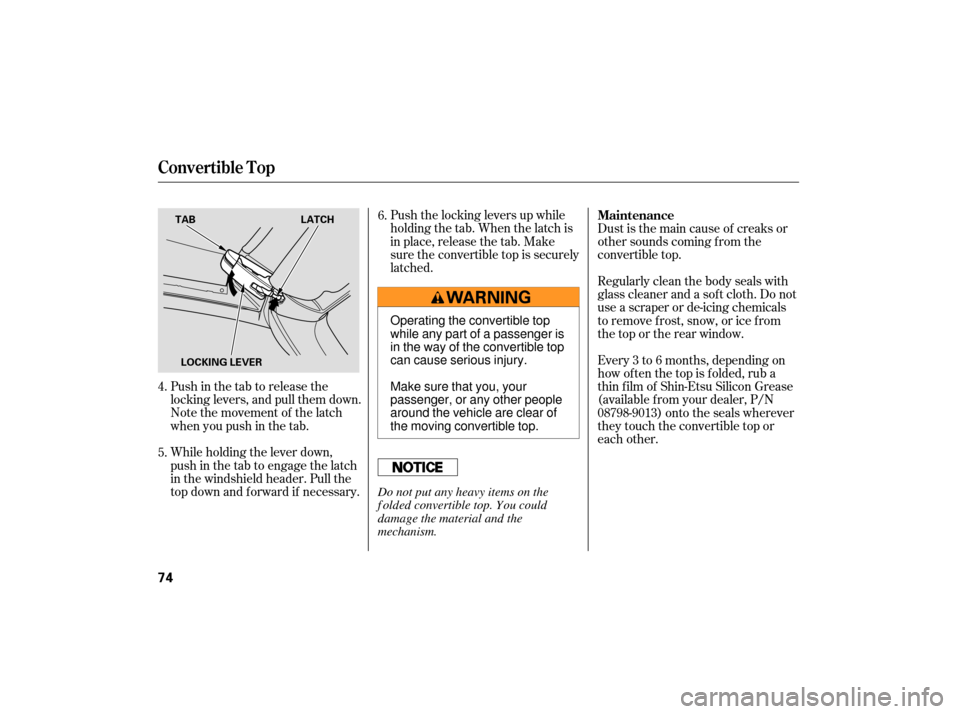Page 76 of 228
Apply the parking brake. The
convertible top will not operate
unless the parking brake is f ully
engaged.
Pull down the strap on the
passenger’s side of the cover, and
align its snap with the pin on the
trim panel behind the door. Press
on both sides of the snap to attach
it to the pin.
Pull down the strap on the driver’s
side of the cover, and align its
snap with the pin on the trim panel
behind the door. Press on both
sides of the snap to attach it to the
pin. Fit the rear of the cover into the
space between the convertible top
and its molding.
To remove the cover, reverse the
procedure.
Turn the ignition switch to the ON
(II) position.
Push the ROOF switch f orward
and hold it. The windows, if raised,
will lower automatically.
The convertible top will rise.
Release the ROOF switch when
the top reaches the windshield
header.
5. 6.1.
2.
3.
4.
7.
CONT INUED
Raising the Convertible T op
Convertible Top
Inst rument s and Cont rols
73
PINSNAP
FASTENER
STRAP
Page 77 of 228

Push in the tab to release the
locking levers, and pull them down.
Note the movement of the latch
when you push in the tab.
While holding the lever down,
push in the tab to engage the latch
in the windshield header. Pull the
topdownandforwardif necessary.Push the locking levers up while
holding the tab. When the latch is
in place, release the tab. Make
sure the convertible top is securely
latched.
Dust is the main cause of creaks or
other sounds coming f rom the
convertible top.
Regularly clean the body seals with
glass cleaner and a soft cloth. Do not
useascraperorde-icingchemicals
to remove f rost, snow, or ice f rom
the top or the rear window.
Every 3 to 6 months, depending on
how of ten the top is f olded, rub a
thin f ilm of Shin-Etsu Silicon Grease
(available f rom your dealer, P/N
08798-9013) onto the seals wherever
they touch the convertible top or
each other.
5. 6.
4. Maintenance
Convertible Top
74
TAB
LATCH
LOCKING LEVER
Operating the convertible top
while any part of a passenger is
in the way of the convertible top
can cause serious injury.
Make sure that you, your
passenger, or any other people
around the vehicle are clear of
the moving convertible top.
Do not put any heavy items on the
f olded convertible top. You could
damage the material and the
mechanism.
Page 87 of 228
Vents, Heating, and A/C
84
AIR CONDITIONING
BUTTONFAN CONTROL LEVER MODE CONTROL DIAL
TEMPERATURE
CONTROL DIAL
REAR WINDOW
DEFOGGER BUTTON
RECIRCULATION BUTTON
Page 88 of 228

Push this lever up and down to
increase or decrease the fan speed
and airflow. The indicato rs next to
the lever show you the speed and
airflow selected.
This button turns the air
conditioning on and off. The
indicator in the button comes on
when the A/C is on.
Tu
rning this dial clockwise increases
the temperature of the airflow. This
button turns the rear window
def ogger of f and on (see page ).
Do not push the def ogger button
when the convertible top is f olded.
Use the mode control dial to select
the vents the air flows from. Some
air will f low f rom the dashboard
vents in all modes.
Air flows from the vents on
both sides of the instrument panel,
andfromthedashboardventinfront
of the passenger.
Airf low is divided between
the vents in the dashboard and the
f loor vents.
When the recirculation indicator is
on, air f rom the vehicle’s interior is
sent through the system again
(recirculation mode). When the
indicator is of f , air is brought in f rom
the outside of the vehicle (f resh air
mode).
The outside air intakes f or the
heating and cooling system are at
the base of the windshield. Keep this
area clear of leaves and other debris.
Thesystemshouldbeleftinfresh
air mode under almost all conditions.
Keeping the system in recirculation
mode, particularly with the A/C of f ,
can cause the windows to fog up.
Switch to recirculation mode when
driving through dusty or smoky
conditions, then return to fresh air
mode. 59
CONT INUED
Vents, Heating, and A/C
Fan Control L ever
Air Conditioning (A/C) Button T emperature Control Dial
Rear Window Def ogger Button
Mode Control Dial
Recirculation Button
A irf low Controls
Features
85
Page 89 of 228

Air conditioning places an extra load
on the engine. Watch the engine
coolant temperatu re gauge (see page
). If it moves near the red zone,
turn of f the A/C until the gauge
reading returns to normal.
you can
cool it down more rapidly by partially
opening the windows, turning on the
A/C, and setting the fan to
maximum speed in f resh air mode.
Air flows from the center
vents in the dashboard above the
audio system, the vents on both
sides of the instrument panel, and
f rom the f loor vents. Select this
position when you drive with the
convertible top f olded.
Air f lows f rom the def roster
vents at the base of the windshield
and the vents on both sides of the
instrument panel. Airf low is divided between
the f loor vents and the def roster
vents at the base of the windshield,
and the vents on both sides of the
instrument panel. Air f lows f rom the f loor
vents and the vents on both sides of
the instrument panel.
When you select or ,
the system automatically switches to
f resh air mode and turns on the A/C. Turn on the A/C by pressing the
button. The indicator in the button
comesonwhenafanspeedis
selected.
Make sure the temperature is set
to maximum cool.
Select .
If the outside air is humid, select
recirculation mode. If the outside
air is dry, select f resh air mode.
Set the f an to the desired speed.
The f low-through ventilation system
draws in outside air, circulates it
through the interior, then exhausts it
through vents behind the seat-backs.
Set the temperature to the lower
limit.
Make sure the A/C is of f .
Select and fresh air mode.
Set the f an to the desired speed.
The heater uses engine coolant to
warm the air. If the engine is cold, it
will be several minutes bef ore you
f eel warm air coming f rom the
system. Select and fresh air mode.
Set the f an to the desired speed.
Adjust the warmth of the air with
the temperature control dial.
1.
2.
3.
4.
1.
2.
3.
1.
2.
3.
4.
5.53
If the interior is very warm,
Vents, Heating, and A/C
Using the A/C
Ventilation
Using the Heater
86
Page 90 of 228

Air conditioning, as it cools, removes
moisture from the air. When used in
combination with the heater, it
makes the interior warm and dry and
can prevent the windows f rom
f ogging up.Turn the fan on.
Turn on the air conditioning.
Select and fresh air mode.
Adjust the temperature to your
pref erence.
This setting is suitable f or all driving
conditions whenever the outside
temperature is above 32°F (0°C).
To remove f og f rom the inside of the
windows: Set the f an to the desired speed, or
high f or f aster def rosting.
Select . The system
automatically switches to f resh air mode and turns on the A/C.
Adjust the temperature so the
airflow feels warm.
Select to help clear the
rear window.
To increase airf low to the
windshield, close the corner vents.
Select . The system
automatically switches to f resh air
mode and turns on the A/C.
Select .Set the f an and temperature
controls to the maximum level.
When you switch to another mode
f rom , the A/C stays on.
Press the A/C button to turn it of f . When you select or ,
the system automatically turns on
the A/C. This helps to dehumidif y
the air and to def og the windshield.
In either mode, you cannot turn of f
theA/C. Foryoursafety,makesureyouhave
a clear view through all the windows
bef ore driving. To clear the windows f aster, you can
close the dashboard corner vents
and the vents on both sides of the
instrument panel by rotating the
wheel below the vent. This will send
more warm air to the windshield
def roster vents. Once the windshield
is clear, select f resh air mode to
avoid f ogging the windows.
Push the f an control level down until
the indicator goes off. A lack of
airf low can cause the windows to f og
up. You should keep the f an on at all
times so stale air and moisture do
not build up in the interior and cause
f ogging.
1.
2.
3.
4.
1.
2. 3.
4.
5.
3.
1.
2.
Vents, Heating, and A/C
Dehumidif y the Interior
To Def og and Def rost T o Remove Exterior Frost or Ice
From the WindowsTo Turn Everything Off
Features
87
Page 126 of 228
Youshoulddothefollowingchecks
and adjustmen ts before you drive
your vehicle.
Make sure all windows, mirrors,
and outside lights are clean and
unobstructed. Remove frost, snow,
or ice. Check
that any items you may be
carrying are stored properly or
fastened down securely. Fasten
your seat belt. Check that
your passenger has fastened his or
her seat belt (see page ).
When you start the engine, check
the gauges and indicato rs in the
instrument panel (see page ).
Check
the seat adjustment (see
page ).
Check the adjustment of the
inside and outside mirrors (see
page ).
Make sure the doors are securely
closed and locked.
Check that the hood is f ully closed.
Check that the trunk is f ully
closed.
Visually check the tires. If a tire
looks low, use a gauge to check its
pressure.
1.
2.
12
3.
4. 5.
6.
7.
8.
9.
10.
67
75 45
Preparing to Drive
Driving
123
Page 130 of 228

Make sure the convertible top and
the windows are closed.
Turn of f the lights.
Place any packages, valuables, etc.,
in the trunk or take them with you.
Lock the doors.
Never park over dry leaves, tall
grass, or other f lammable
materials. The hot three way
catalytic converter could cause
these materials to catch on fire.If the vehicle is f acing uphill, turn
the front wheels away from the
curb, and put the transmission in
f irst gear.
If the vehicle is f acing downhill,
turn the front wheels toward the
curb, and put the transmission in
reverse gear.
Make sure the parking brake is
f ully released bef ore driving away.
Driving with the parking brake
partially set can overheat or
damage the rear brakes.
Resting your f oot on the pedal keeps
the brakes applied lightly, builds up
heat, and reduces their ef f ectiveness.
It also keeps your brake lights on all
the time, conf using drivers behind
you.
Constant application of the brakes
when going down a long hill builds
up heat and reduces their ef f ective-
ness. Use the engine to assist the
brakes by taking your f oot of f the
accelerator and downshif ting to a
lower gear. Your vehicle is equipped with disc
brakes at all f our wheels. A power
assist helps reduce the ef f ort needed
on the brake pedal. The anti-lock
brake system (ABS) helps you retain
steering control when braking very
hard.
Always use the parking brake when
you park your vehicle. Make sure
the parking brake is set f irmly, or
your vehicle may roll if it is parked
on an incline.
CONT INUED
Parking
Parking T ips Braking System
Parking, Braking System
Driving
127